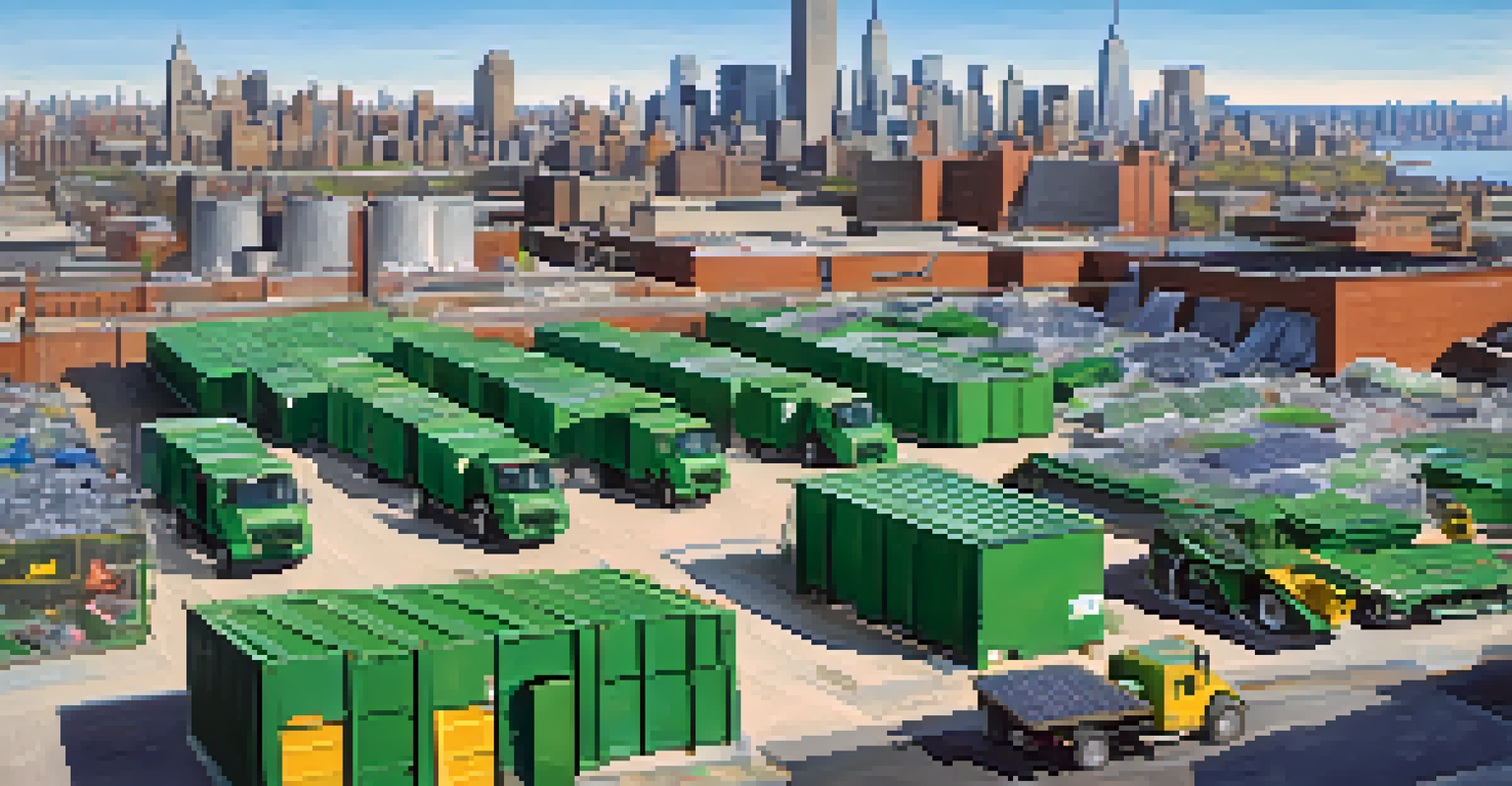NYC's Waste Management System: A Backbone of Urban Infrastructure

Understanding the Importance of Waste Management in NYC
Waste management is crucial for any urban environment, especially in a bustling metropolis like New York City. It ensures public health and cleanliness, preventing pollution and the spread of diseases. Without an efficient waste management system, the streets would quickly become overwhelmed with trash, affecting both residents and visitors alike.
The greatest threat to our planet is the belief that someone else will save it.
In NYC, the waste management system is not just about trash collection; it encompasses recycling, composting, and waste reduction. This comprehensive approach helps minimize landfill use and encourages sustainable practices among its citizens. By understanding the importance of proper waste disposal, New Yorkers can contribute to a cleaner, greener city.
Moreover, waste management plays a pivotal role in maintaining the city's reputation. Tourists flock to NYC for its vibrant culture and stunning sights, but a dirty city can tarnish that image. An effective waste management system is essential to keep the city inviting and enjoyable for everyone.
The Structure of NYC's Waste Management System
NYC's waste management system is a complex network involving multiple agencies and private companies. The Department of Sanitation (DSNY) is the primary agency responsible for waste collection, recycling, and street cleaning. With over 6,000 employees and a fleet of specialized vehicles, they work tirelessly to keep the city's streets clean and trash-free.

In addition to the DSNY, there are numerous private carting companies that handle waste collection for businesses and institutions. This dual system allows for flexibility and efficiency, ensuring that waste is managed promptly and effectively. The collaboration between public and private sectors is essential in meeting the city's diverse waste management needs.
Waste Management Ensures Public Health
An effective waste management system in NYC is essential for maintaining cleanliness and preventing pollution, thereby safeguarding public health.
Furthermore, the city's waste management system includes innovative initiatives like the NYC Organics Collection Program. This program encourages residents to compost their food scraps, significantly reducing the amount of organic waste sent to landfills. Such initiatives showcase how the system adapts to modern challenges while promoting sustainability.
Challenges Facing NYC's Waste Management System
Despite its robust infrastructure, NYC's waste management system faces numerous challenges. One major issue is the sheer volume of waste generated by its 8.6 million residents and millions of daily visitors. This constant influx can strain the system, leading to overflow and delays in collection services.
We do not inherit the earth from our ancestors, we borrow it from our children.
Additionally, illegal dumping and littering create ongoing hurdles for waste management efforts. These activities not only degrade the environment but also require additional resources to address. Public awareness and community involvement are crucial in combating these issues and fostering a culture of respect for the urban landscape.
Another challenge is the city's ambitious goal to reduce waste by 90% by 2030. Achieving this target requires innovative strategies, increased recycling rates, and community engagement. By confronting these challenges head-on, NYC can continue to evolve its waste management practices for a sustainable future.
Innovations in Waste Management Technology
Innovation plays a vital role in enhancing NYC's waste management system. The city is increasingly adopting smart technology to improve efficiency and reduce costs. For instance, sensors in waste bins can monitor fill levels, allowing for more efficient collection routes and minimizing unnecessary pickups.
Moreover, NYC is piloting initiatives that incorporate data analytics to track waste generation patterns. By analyzing this data, city planners can make informed decisions about resource allocation and service improvements. This tech-driven approach not only streamlines operations but also sets a precedent for other urban areas to follow.
Community Engagement Drives Success
Active participation from residents in waste disposal and recycling initiatives is crucial for the success of NYC's sustainability goals.
In addition, the use of electric waste collection vehicles is on the rise, aligning with the city's sustainability goals. These vehicles produce fewer emissions, contributing to cleaner air and a healthier environment. As technology continues to advance, NYC's waste management system is poised to become more efficient and eco-friendly.
The Role of Community Engagement in Waste Management
Community engagement is essential in ensuring the success of NYC's waste management initiatives. Residents play a crucial role in proper waste disposal, recycling, and composting efforts. By fostering a sense of responsibility and accountability, the city can achieve its sustainability goals more effectively.
Programs like the NYC Department of Sanitation's 'Zero Waste' initiative aim to educate the public on effective waste management practices. Workshops, events, and educational materials encourage residents to reduce waste and participate in composting and recycling programs. The more informed the community is, the more likely they are to take action.
Additionally, local organizations and neighborhood groups often spearhead clean-up efforts, showcasing the power of collective action. When communities come together to address waste issues, it not only beautifies the environment but also strengthens community ties. This collaborative spirit is vital for fostering a culture of sustainability in NYC.
The Future of Waste Management in NYC
As NYC continues to grow, its waste management system must also evolve to meet new challenges. Future strategies may include expanding recycling programs, enhancing public transportation for waste collection, and investing in waste-to-energy technologies. These approaches can help the city manage its waste more sustainably while addressing environmental concerns.
Additionally, fostering a circular economy where waste is minimized and resources are reused will be crucial. This involves rethinking production and consumption patterns to ensure that materials are kept in use for as long as possible. By adopting these practices, NYC can significantly reduce its environmental footprint.
Innovation Enhances Waste Management
The adoption of smart technology and data analytics is transforming NYC's waste management system, improving efficiency and promoting eco-friendly practices.
Ultimately, the future of waste management in NYC relies on collaboration among government, businesses, and residents. By working together, the city can build a more sustainable and resilient waste management system, safeguarding the environment for generations to come.
Conclusion: NYC's Waste Management System as a Model for Cities
In conclusion, NYC's waste management system is a vital part of its urban infrastructure, supporting a clean and healthy environment for its residents. Despite facing various challenges, the city continues to innovate and adapt, demonstrating a commitment to sustainability. Community engagement, technological advancements, and effective policies are all integral to its success.
As other cities look to improve their waste management systems, they can learn valuable lessons from NYC's experiences. By prioritizing collaboration and embracing innovation, urban areas worldwide can work towards more sustainable waste management practices. NYC's journey serves as an inspiration for cities aiming to create cleaner, more livable spaces.

Ultimately, a well-functioning waste management system is not just a necessity; it is a reflection of a city's values and priorities. As NYC continues to lead the way in waste management, it sets a standard for others to aspire to, proving that a cleaner future is possible through collective effort.